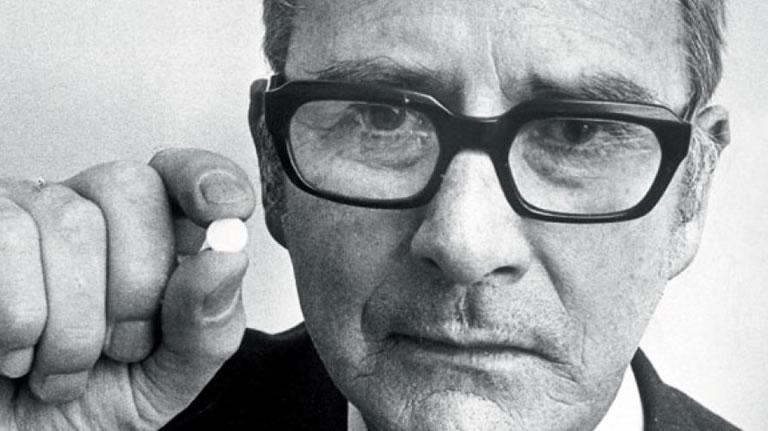John Cade (Dr) |

John Cade was born in Murtoa was a phsychiatrist credited with discovering the effects of lithium carbonate as a mood stabilizer in the treatment of bipolar disorder
Dr John Frederick Joseph Cade (1912-1980) was an Australian psychiatrist who made perhaps one of the most important medical discoveries to sway mental health here and the world over when he found the first effective chemical treatment that would help those who suffered depression and bipolar disorder.
Known for being a quiet and unassuming man who had a good sense of humour, John Cade was more than modest about his own remarkable discovery. In a book that he published in 1979, Mending the Mind, he made mention of the successful use of Lithium without mentioning any part that he himself played in its applications.
Although it's stated in many references that John Cade was born in Horsham, a large town in the area of Wimmera, he was in fact born in Murtoa, another town located 32 kilometres North East of Horsham, a fact recorded by Cade's own son Jack Cade.
During the 1940s, at a time when there was still little understanding of mental illness and the many forms it could take, John Cade made the discovery that Lithium could be used to treat bipolar disorder and manic depression, effectively discovering the first medication that could successfully treat such cases. This was at a time when the most common methods were still barbaric in light of treatments offered today, with lobotomies and electro shock therapy still widely in use at the time to treat mental disorders.
The son of a medical practitioner, John Cade was a prisoner of war at Changi from February 1942 to September 1945. Having already had a career in the field of psychiatry, it's been suggested the suffering and mental anguish he saw while there may have furthered his interest in helping those who suffered manic disorders and depression.
Following his return to Australia, it was in 1948 while Dr John Cade held a position at Bundoora Repatriation Mental Hospital that he used a simple kitchen at the facility to conduct his experiments which led to the discovery of lithium as a successful treatment.
Cade was testing a theory that was based in part upon an antiquated misconception that there was a link between manic disorders and urea, and organic compound in urine first discovered in 1773 by the French chemist Hilaire Rouelle. Rather than assuming that urea itself was a cause of mania, John Cade surmised that manic patients may have had a metabolic disorder, which could be gauged by an excessive amount of urea in their urine.
Using guinea pigs, Dr Cade injected urine from mentally ill patients into the abdomen of the guinea pigs and found that they dies faster than those that were injected with a healthy sample of urine. His findings made him wonder if the samples from mentally ill patients contained a higher level of uric acid, something he attempted to correct by adding Lithium to the solution of uric acid.
It was by doing this that Cade made the remarkable discovery that by adding Lithium, he not only reduced the toxicity of the uric acid, but it also appeared to bring a calming effect to the guinea pigs - because naturally it would be a tad alarming to have another's urine injected into one's self!
Expanding on his findings, Dr Cade began carefully controlled experiments revealed that the Lithium ion itself had a calming effect on the guinea pigs. After taking the lithium himself to ensure its safety, Cade began trials with a small number of patients, administering lithium citrate and also lithium carbonate on patients who'd been diagnosed with mania, dementia præcox or melancholia. The results were so successful that Cade speculated that mania was caused by a deficiency in lithium. His results were published in a paper he wrote, Lithium salts in the treatment of psychotic excitement, which was published in the Medical Journal of Australia in 1949.
Although Lithium was being widely used and recognised to treat depression and bipolar disorders, Lithium is in fact a salt, which is a naturally-occurring chemical, and so it couldn't ever be patented. This meant that the manufacturing and selling of Lithium was never seen as commercially viable as a treatment - something which ideally wouldn't have been a factor at all - and it's use was never widespread until the 1960s, although America lagged behind in recognising its benefits.
The use of Lithium as a psychiatric treatment was in fact banned in the United States until 1970, despite there having been successful trials of Dr Cade's findings since his important discovery. The banning of Lithium was due to the fact that the chemical had been available in the US much earlier, although for very different reasons. Used misguidedly as a cure for other afflictions, and even as a food seasoning, earlier uses in the US had led to cases of toxicity and even death, causing its withdrawal from the market.
It was in 1970, following trials and legislation that made Lithium available as a treatment for mental disorder, that John Cade received the American psychiatric award of the Taylor Manor Hospital in Maryland, United States of America. He was also made a distinguished fellow of the American Psychiatric Association and it was at this time that the use of Lithium truly gained popularity the world over.
A discovery that has had far-reaching benefits for the community and those who suffer bipolar and manic disorders, in 1985 the American National Institute of Mental Health estimated that Cade's discovery of Lithium in the treatment of manic depression had saved the world at least $US 17.5 billion in medical costs.
❊ Web Links ❊
➼ John Cade (Dr)
➼ www.wikipedia.org/John_Cade
➼ www..wikipedia.org/Lithium_carbonate
➼ www.bipolar-lives.com
Disclaimer: Check with the venue (web links) before making plans, travelling or buying tickets.
Accessibility: Contact the venue for accessibility information.
Update Page








